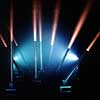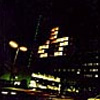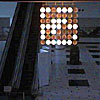HISTORY
Searchlights have been around for well over 100 years. The use of tightly collimated beams was typical of the first World Exhibitions where they were used to visualize the new energy that gave birth to modernity: electricity. Illuminating engineers were in high demand at the beginning of the 20th century, as described by Daniel Canogar, among others. Not only were they used for highlighting emblematic buildings but also to direct aeroplanes into landing trajectories. The use of collimated searchlights in Albert Speer’s Nazi spectacles produced intimidating architectures of monologic power where, as Canogar points out, people were props in the fascist spectacle. During the war, searchlights were used as a tracking devices for anti-aircraft surveillance, a function that was later replaced by the invention of the computer mouse, as Axel Roch shows.
At the end of the Second World War, searchlights were used in Victory parades and since then have been associated with celebration. Today, searchlights are used mostly by corporate or public events that try to recreate a festive environment that we associate with a Hollywood film premiere, using repetitive light sequences.
Vectorial Elevation was first produced in 1999 for the Zócalo Square in Mexico City. Its main objective is to allow public control of the spectacular lighting possible with searchlights, which normally follows a pre-programmed sequence of movements. There are a large number of precedents and inspirations for this type of work. Here are a few from before the project was first developed in 1999:

 Laszlo Moholy-Nagy
Laszlo Moholy-Nagy
“Telephone Pictures”, 1922
Moholy-Nagy ordered five paintings from a factory; the images that were to appear in the paintings were dictated over the phone.
 E.A.T. - Experiments in Art and Technology
E.A.T. - Experiments in Art and Technology
"Telex: Q&A", New York, Stockholm, Ahmededabad, Tokyo, 1971. Four telex terminals were set-up in New York, Stockholm, Ahmedabad, and Tokyo. The public in each of the four countries submitted questions and the corresponding answers to participants in the other cities.
 Sol LeWitt
Sol LeWitt
"Cube Structures Based on Five Modules", 1971-1974
Sol LeWitt works with modules and systems that are simple and impersonal, to explore repetition and seriality. His works perfected the concept of "instructions" as a form of Art.
 Otto Piene
Otto Piene
"Olympic Rainbow", XX Olympic Games Munich, Germany, 1972
One of Piene's "Sky Art" projects was the 1,600 foot "Olympic Rainbow" for the closing ceremony of the Munich Olympic Games in 1972.
 Kit Galloway, Sherrie Rabinowitz
Kit Galloway, Sherrie Rabinowitz
"Satellite Arts Project ‘77", 1975-1977
This project, the first example of telecollaborative arts, allowed artists who were geographically separated to perform together through the use of video transmissions.
 Toyo Ito
Toyo Ito
"Tower of Winds", Yokohama, 1986
Toyo Ito’s interactive architecture, such as his 1986 Tower of Winds in Yokohama, transforms on environmental changes such as noises and the speed and direction of the wind.
 Eduardo Kac and Ed Bennett
Eduardo Kac and Ed Bennett
"Ornitorrinco" 1989
Ornitorrinco the telerobot was a first contact with the prolific field of artistic teleoperation.
 X-Space
X-Space
"Winke, Winke: A message transmission", Austria, 1993
Winke, Winke allows participants to send messages via access terminals and Internet connection to a robot that translates these messages into signals of the International Semaphor System.
 Louis Phillippe Demers and Bill Vorn
Louis Phillippe Demers and Bill Vorn
"Espace Vectoriel", Montréal 1993
An installation where the presence of the public triggered motion patterns and sounds from robotic light assemblies.
 Christian Möller and Joachim Sauter
Christian Möller and Joachim Sauter
"Networked Skin", Linz 1994
A project for the Ars Electronica Center, designed to transform the building with a global interface.
 Rafael Lozano-Hemmer and Will Bauer
Rafael Lozano-Hemmer and Will Bauer
"The Trace", Madrid 1995
An installation where two remote participants shared the same telematic space constructed with intersecting light beams.
 ETV Hackers, Delft U of T
ETV Hackers, Delft U of T
"The World's Largest Tetris Game", Faculty Building of Electrical Engineering, Delft U of T, Netherlands, 1995
People all over the world could play the game Tetris by using a simple telnet session and all the West of Holland could watch what they were doing on the building. At the same time the Telecom Student Club of ETV used a GSM telephone and a laptop to put every 10 seconds a picture on the Web.
 Knowbotic Research
Knowbotic Research
"Anonymous Muttering" 1996-97
An installation featuring real time intersection of net data with sound and light transformation.
 Masaki Fujihata
Masaki Fujihata
"Light on the Net" Project, 1996
A piece that allows turning individual lightbulbs on a display in Tokyo.
 Ken Goldberg
Ken Goldberg
"Dislocation of Intimacy" 1998
A telepresence piece which allows participants on the web to turn lights on and off and watch the shadows produced by an offscreen installation.
 Hans Muller and Zwarts / Jansma Architecten
Hans Muller and Zwarts / Jansma Architecten
Leidschenveen Tunnel installation, 1998
A piece that allows people to send messages over the net, which are then presented in an electronic display in public space.
 Stadtwerkstatt
Stadtwerkstatt
"Clickspace" Linz, 1998
A three module project that allowed light, sounds and messages to be displayed in various buildings in Linz, Austria.
 Association Creation
Association Creation
"Bump", Linz, 1999
A catwalk - 1.5 by 20 meters - is installed in the public space of each city involved. When a person steps onto the catwalk their weight triggers an impulse that is transferred into the other city by means of a data-line. There, a pneumatic piston raises the corresponding board by a few centimetres.
 Germaine Koh
Germaine Koh
"Prayer", Ottawa, Ontario, Canada, 1999
A computer captures keystrokes and converts them into Morse-encoded puffs of smoke that are released through a vent in the building.
